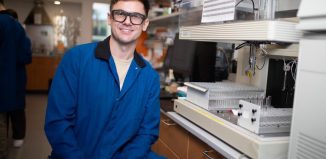SBU asst prof Greg Hajcak studies anxiety and depression
Some have suggested that the link is so tight that they are manifestations of the same disease
The answer is A, not B. The appointment was at 11 am on Tuesday, not 1 pm. The Magna Carta was signed in 1215, not 1512. You’re wrong, you’re wrong, you’re wrong!
Those are innocent enough mistakes. It turns out, though, that the neurological reaction to those mistakes is different for some children, especially those with anxiety disorders.
Stony Brook assistant psychology professor Greg Hajcak (pronounced “high-chuck”) has found that the brains of different children react to mistakes differently. An anxious child will likely have a larger neurological response than the brain of someone who shows no signs of anxiety.
Hajcak treats patients at the Anxiety Disorders Clinic while he also does research to look for ways the brains of people with different disorders react under various conditions.
In a doctor’s office, many children present symptoms that are nearly identical in cases of anxiety or depression.
“The link in anxiety and depression is so tight that some have suggested these aren’t really separate diseases, but are manifestations of the same disease,” Hajcak offered.
That’s not the case, however, when the brain responds to mistakes. Putting caps that look like Olympic swimwear (except for the noninvasive electrodes inside them) on the heads of his young subjects, Hajcak conducted electroencephalograms (EEGs) as his young charges performed tasks in his lab. The children with anxiety disorder showed stronger electrical reactions after errors even than those with depression.
This kind of information could be helpful for parents and doctors, especially if it provides early evidence of the development of emotional challenges.
Hajcak’s research provides the “notion that we could have unique markers for these difficult-to-distinguish disorders,” he suggested. “We might be able to say what the earliest place where we could differentiate the trajectories of risk.”
That could be useful for the 10 to 20 percent of the population that will likely have an anxiety disorder before they’re 18, explained Hajcak.
To be sure, Hajcak and other researchers are years from being able to connect brainwave activity in response to a test or set of tests to the likelihood of a disorder.
Nonetheless, these types of studies are important first steps in looking for signs of anxiety or depression that could become useful for children, parents, and mental health professionals.
Hajcak recognizes that these markers could suggest to parents what kind of programs might help their children if they see signs of anxiety.
Like any biological marker, a potential sign for anxiety disorder could become one part of the total medical picture.
“If we know that child A vs. child B is at risk, it’s just a risk factor,” he explained.
The son of a retired clinical psychologist, Hajcak described himself as a “more worried kid” when he was younger. “Lots of people in clinical psychology would say that people tend to study things that are more relevant to them. Those personality features drew me to the anxiety world.”
A resident of Manhattan who commutes to Stony Brook to do his clinical and research work, Hajcak said he had a unique opportunity when he attended graduate school at the University of Delaware to study with Edna Foa, who works at the University of Pennsylvania. Foa, whom Hajcak described as “one of the foremost experts on anxiety disorders,” was named one of Time Magazine’s 100 most influential people in the world in 2010.
Hajcak worked with Foa for four years, during which time he learned “everything I know about anxiety disorders and their treatment,” including cognitive therapy, an especially effective solution for anxiety.
“Treating anxiety disorders is so fulfilling,” he offered. “It works so well: 75 percent or more of people will see at least a 50 percent reduction in symptoms. That’s pretty much as good as it gets in the mental health world.”
Hajcak got engaged earlier this month to Christine Proudfit, an obstetrician/ gynecologist who works with high-risk pregnancies at New York University. The couple, who work out together at the gym, also have plans to marry their professional pursuits. They have talked about examining how anxiety among low and high-risk populations relates to obstetrical and neonatal outcomes.
In the world of pregnancy, labor and childbirth, where new mothers face daunting challenges, anxiety can go hand-in-hand with picking out names and shopping for baby clothing.
“Unknowns and uncertainty,” explained Hajcak “are the wind in the sails of anxiety.”






